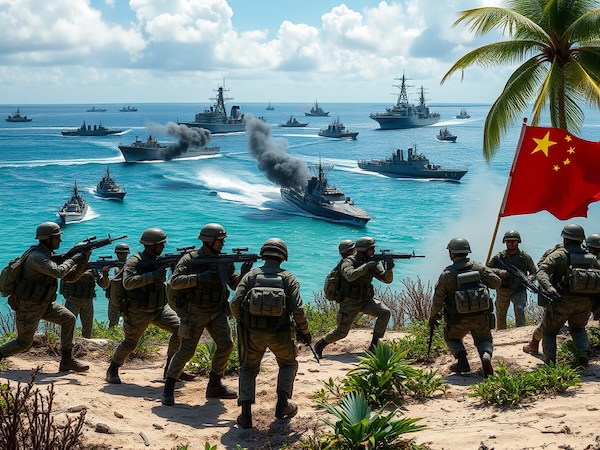Successful Trade Talks With China Requires a True Assessment of Its Strengths
By Tom Kagy | 10 May, 2025
The talks in progress in Switzerland can be doomed by an outdated and false notion that the US economy still dominates China's.
The US and China are now engaging in what amounts to peace talks to ease out of a very open trade war. If talks go badly the relationship has the potential to degenerate into a hot war. Of course neither side wants a shooting war. But the zany bluster we've heard from Trump & Co makes us wonder if they're clear-eyed in estimating China's strength.
Assuming continued growth at the 6.16% rate averaged over the past decade, China would take about 13 years to overtake the US whose growth has averaged 2.31%. For 2025 the IMF projects US GDP at $30.5 trillion compared with only $19.2 trillion for China.
But those figures are on a nominal dollar-denominated basis which is vastly different from steel and concrete reality as they incorporate the large premium the US dollar enjoys as the world's reserve currency. This premium is based on the perception of the US as a historically stable society committed to free-trade — assumptions that have recently come under serious question.
Looking at the two economies on a real-world purchasing power parity (PPP) basis, the picture is quite different. It uses the same $30.5 tril. GDP for the US but a whopping $40.7 tril. GDP for China. So the material (vs paper) reality is that China already produces about 34% more goods and services than the US. In terms of sheer industrial production capacity China enjoys a 2:1 edge over the US, according to the most recent estimates.
In military terms the nominal US annual defense budget of $895 billion overwhelms China's defense budget of $266.9 billion by a factor of 3.4. But on a PPP basis the difference is far less, $895 bil. vs about $545 bil. Assuming each nation's defense spending keeps pace with its economy, in a decade the US defense budget on a PPP basis would be $1.13 tril. vs $1.15 tril. for China.
Comparing capital military assets provides a more concrete view of the reality behind the US-China military competition. The PLA Navy (PLAN) currently operates 234 warships vs 219 by the US Navy. More importantly, the US will fall farther behind each year due to China's shipbuilding capacity surpassing the US by more than 200 times.
The looming numerical disparity can't be discounted by the old assumption of US qualitative advantage. Aside from the fact that 70% of PLAN warships were launched after 2010 vs only 25% of the USN fleet, a recent US assessment suggests that China's newest vessels have attained parity with US counterparts.
In air power the US still holds a big edge for now, with a pronounced quantitative as well as a meaningful qualitative edge. But looking ahead China has taken a big lead in the development of sixth-generation fighter jets. It has already produced two prototypes while the US only recently awarded its first sixth-gen development contract to Boeing.
The perception of China's air-to-air missile technology received a big boost in the recent encounter in which a Pakistani pilot flying a China-built Chengdu J-10C killed at least two Rafales, possibly more, presumably with PL-15E active-radar-guided missiles fired far beyond visual range.
To complete the military comparison, in terms of land forces China enjoys a daunting quantitative advantage, with about 50% more troops, tanks and artillery, and a 4-to-1 edge in the scale of its military recruitment pool which becomes critical in a prolonged war like the one in progress in the Ukraine.
Recent war games using computer simulation showed the US losing about 900 planes and a good part of its naval fleet in the first days but ultimately keeping Taiwan from being taken by Chinese forces. An earlier Air Force simulation shows China using biological weapons to quickly win the war. These simulations place heavy emphasis on armaments which are easy for computers to simulate. In actual wars armaments tend to neutralize each other on a quid-pro-quo basis, with the outcome turning on ground battles to take and hold territory.
Since neither nation is likely to go nuclear, a US-China war would entail troops engaging over months or, if common sense doesn't quickly prevail, even several years. The war would of course entail sustained naval battles across a million square miles of the South and East China Seas. But ground battles would be inevitable on Taiwan, Guam, the Philippines. If things go badly for China, the fighting would spread to the Chinese mainland. If things go badly for the US, the battles could spread to the Hawaiian Islands, or even Alaska and the west coast of the mainland.
In a sustained war the outcome would turn on industrial capacity and manpower, both of which favor China. But participation by US allies Japan, S. Korea and Taiwan — all of whom Trump has alienated with his zany tariffs — may ultimately tilt the balance in US favor.
The bottom line is that negotiators must understand that the US no longer holds some mythical ultimate advantage should the Trump-made trade war become a sustained and escalating contest of wills. Our best strategy is recognizing that the US has had it very very good until Trump's tariffs destroyed our position as the exceptionally stable and open society attracting the world's top talent and capital seeking safety. That's what has kept the US wealthy. We can only hope Trump and his team recognize the need to revert as quickly as possible to that blessed state. It will be impossible to reclaim if the US continues down the protectionist path much longer.

Asian American Success Stories
- The 130 Most Inspiring Asian Americans of All Time
- 12 Most Brilliant Asian Americans
- Greatest Asian American War Heroes
- Asian American Digital Pioneers
- New Asian American Imagemakers
- Asian American Innovators
- The 20 Most Inspiring Asian Sports Stars
- 5 Most Daring Asian Americans
- Surprising Superstars
- TV’s Hottest Asians
- 100 Greatest Asian American Entrepreneurs
- Asian American Wonder Women
- Greatest Asian American Rags-to-Riches Stories
- Notable Asian American Professionals

